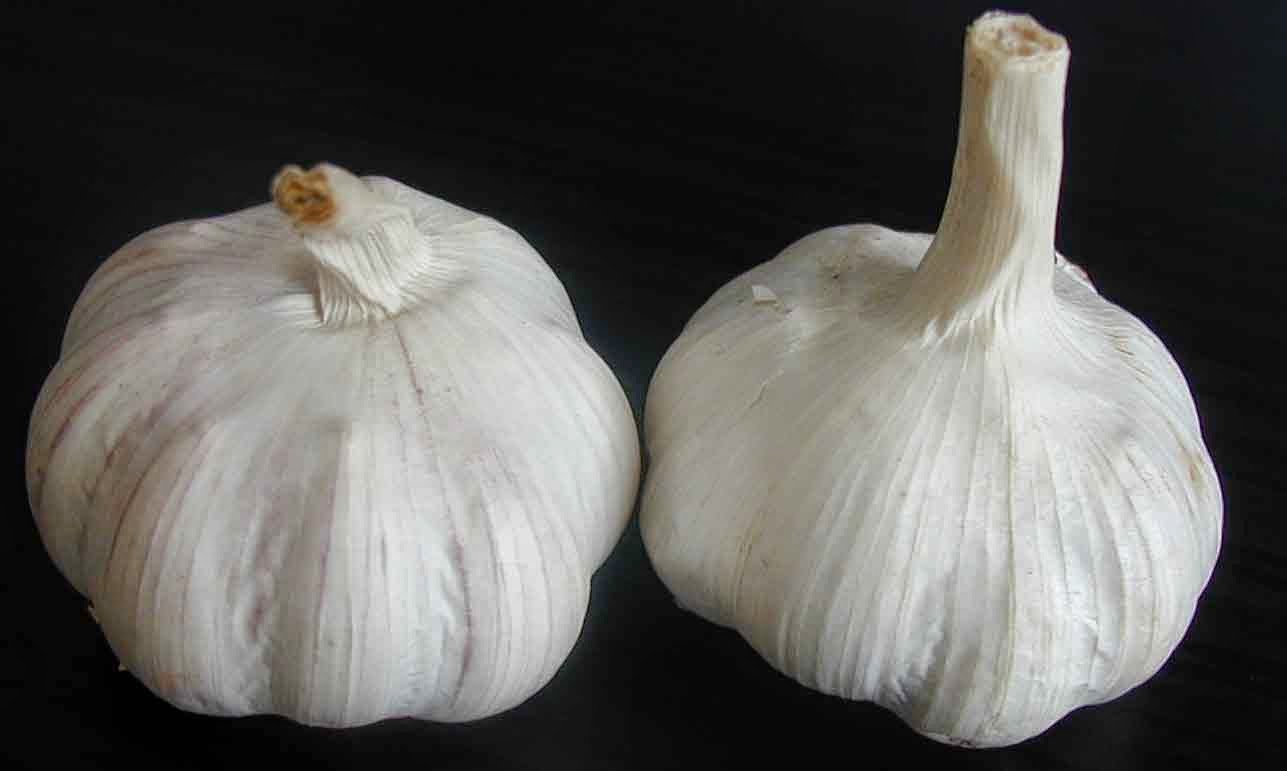Garlic - the best medicine in world
Garlic

 Supplementation with garlic extract inhibited vascular calcification in human patients with high blood cholesterol. The known vasodilative effect of garlic is possibly caused by
Supplementation with garlic extract inhibited vascular calcification in human patients with high blood cholesterol. The known vasodilative effect of garlic is possibly caused by
Allium sativum, commonly known as garlic, is a species in the onion genus, Allium.
Its close relatives include the onion, shallot, leek, chive, and rakkyo. With a history of human use of over 7,000 years, garlic is native to central Asia, and has long been a staple in the Mediterranean region, as well as a frequent seasoning in Asia, Africa, and Europe.
Medicinal use and health benefits
Animal studies, and some early research studies in humans, have suggested possible cardiovascular benefits of garlic. Many studies found garlic supplementation reduced accumulation of cholesterol on the vascular walls of animals and in humans.
Another study had similar results, with garlic supplementation significantly reducing aortic plaque deposits of cholesterol-fed rabbits.catabolism of garlic-derived polysulfides tohydrogen sulfide in red blood cells (RBCs), a reaction that is dependent on reduced thiols in or on the RBC membrane. Hydrogen sulfide is an endogenous cardioprotective vascular cell-signaling molecule.


A 2012 meta-analysis of randomized, double-blind, placebo-controlled trials looking at the effects of garlic on serum lipid profiles, found garlic was superior to placebo in reducing serum total cholesterol and triglyceride levels. Compared with the placebo groups, serum total cholesterol and triglyceride levels in the garlic groups was reduced by 0.28 (95% CI, −0.45, −0.11) mmol L⁻¹ (P = 0.001) and 0.13 (95% CI, −0.20, −0.06) mmol L⁻¹ (P < 0.001), respectively.
Allium sativum has been found to reduce platelet aggregation and hyperlipidemia.
In 2007, the BBC. reported Allium sativum may have other beneficial properties, such as preventing and fighting the common cold. This assertion has the backing of long tradition in herbal medicine, which has used garlic for hoarseness and coughs. The Cherokee also used it as an expectorant for coughs and croup. However, in contrast to these earlier claims concerning the cold-preventing properties of garlic, a 2012 report in the Cochrane Database of Systematic Reviewsconcludes that "there is insufficient clinical trial evidence regarding the effects of garlic in preventing or treating the common cold. A single trial suggested that garlic may prevent occurrences of the common cold but more studies are needed to validate this finding. Claims of effectiveness appear to rely largely on poor-quality evidence."
Garlic is also alleged to help regulate blood sugar levels. Regular and prolonged use of therapeutic amounts of aged garlic extracts lower blood homocysteine levels and has been shown to prevent some complications of diabetes mellitus. People taking insulinshould not consume medicinal amounts of garlic without consulting a physician.
Garlic was used as an antiseptic to prevent gangrene during World War I and World War II.[79] More recently, it has been found from a clinical trial that a mouthwash containing 2.5% fresh garlic shows good antimicrobial activity, although the majority of the participants reported an unpleasant taste and halitosis.
Garlic cloves are used as a remedy for infections (especially chest problems), digestive disorders, and fungal infections such asthrush. Garlic can be used as a disinfectant because of its bacteriostatic and bactericidal properties.
Garlic has been found to enhance thiamin absorption, and therefore reduces the likelihood for developing the thiamin deficiency beriberi.
In 1924, it was found to be an effective way to prevent scurvy, because of its high vitamin C content.
Garlic has been used reasonably successfully in AIDS patients to treat Cryptosporidium in an uncontrolled study in China. It has also been used by at least one AIDS patient to treat toxoplasmosis, another protozoal disease.
Garlic supplementation has been shown to boost testosterone levels and the plasma Luteinizing Hormone in rats fed a high protein diet.
A 2010 double-blind, parallel, randomized, placebo-controlled trial, involving 50 patients whose routine clinical records in general practice documented treated but uncontrolledhypertension, concluded, "Our trial suggests that aged garlic extract is superior to placebo in lowering systolic blood pressure similarly to current first line medications in patients with treated but uncontrolled hypertension."[87]
Studies suggest that allicin, a compound found in garlic, may prove to be effective in the treatment of MRSA.
Other uses
The sticky juice within the bulb cloves is used as an adhesive in mending glass and porcelain.[2] An environmentally benign garlic-derived polysulfide product is approved for use in the European Union (under Annex 1 of 91/414) and the UK as a nematicide and insecticide, including for use for control of cabbage root fly and red mite in poultry.
Garlic along with cinnamon is used as a fish and meat preservative, and displays antimicrobial property at temperatures as high as 120 degree Celsius; the combination can also be used to preserve fried and deep fried foods, and in the future might be used in an inner layer of plastic
(ref:en.wikipedia.com)
(ref:en.wikipedia.com)
Thanks
for reading this………….



Comments
Post a Comment